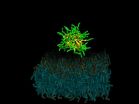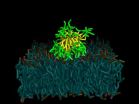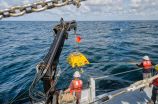(Press-News.org) Scientists are planning for a future in which superbugs gain the upper hand against our current arsenal of antibiotics. One emerging class of drug candidates, called AMLPs (antimicrobial lipopeptides), shows promise, and an August 18 study in the Biophysical Journal explains why: they selectively kill bacterial cells, while sparing mammalian host cells, by clumping together into microscopic balls that stick to the bacterial membrane--a complex structure that will be slower to mutate and thus resist drugs.
"The pressing need for novel antibiotics against resistant strains of bacteria and fungi has become a global medical concern," says senior study author Alan Grossfield of the University of Rochester Medical Center in New York. "Our new insights into how AMLPs work as groups rather than individually could optimize the development of these molecules as a new class of anti-resistance antibiotics."
AMLPs could represent a promising alternative to traditional antibiotics. Past studies have shown that these synthetic compounds have potent activity against a range of pathogens and can clear infections in mice. Moreover, AMLPs are less vulnerable to evolved resistance because they disrupt the structure and function of microbial membranes. To evolve drug resistance, the microbes would require many big changes to alter the mixture of lipids composing the membrane. In addition, a variety of critical proteins embedded in the membrane depend on the membrane's current composition of lipids, so membrane changes that would prevent AMLP function would also tend to hinder the function of the bacteria's own membrane proteins.
Despite their advantages, progress in developing AMLPs suitable for the clinic has been limited by the lack of a molecular-level understanding of their mode of action. In particular, it is not clear whether and how the tendency of AMLPs to form clumps improves their antimicrobial activity. To address this question, Grossfield and graduate student Dejun Lin used molecular-dynamics simulations and free-energy calculations to examine whether the tendency of AMLPs to aggregate into larger balls, called micelles, affects their ability to bind to membranes.
Their computational approach revealed that isolated AMLPs had a tendency to bind strongly and rapidly to whatever membrane they encountered first, because binding to either bacterial or mammalian membranes was thermodynamically favorable. By contrast, micelles strongly preferred bacterial membranes over mammalian membranes, in part because of a higher thermodynamic binding affinity for bacterial membranes.
Moreover, the membrane composition in mammalian cells was associated with a higher free-energy barrier, which interfered with the speed and efficiency with which the drug entered the membrane, whereas binding to the bacterial membrane was more kinetically favorable. Grossfield and his collaborators are now using insights from this study to examine whether it is possible to improve the function of related molecules.
"The biggest surprise was that the binding kinetics--in essence, how quickly the lipopeptides get into the membrane--are crucial to understanding how they work," Grossfield says. "It turns out that it's not enough to look at the drug molecule itself, it's also important to consider whether it works by itself or as part of a group. The micelles attack bacterial membranes much faster, which explains why they kill bacteria without hurting the infected animal."
Taken together, the new findings suggest that the formation of micelles is a strong determinant of binding kinetics and selectivity for microbial cells. "Controlling this process by chemically modifying AMLPs to promote their aggregation will be important for optimizing their potency while minimizing side effects in host cells," Grossfield says.
"Because AMLPs are small and stable, manufacturing, processing, and storing them is relatively easy and inexpensive, making them suitable for drug development," he adds. "We are optimistic that AMLPs will eventually make their way into the clinic as a much-needed option for overcoming antibiotic resistance."
INFORMATION:
This work was supported by the National Institutes of Health.
Biophysical Journal, Lin and Grossfield: "Thermodynamics of Micelle Formation and Membrane Fusion Modulate Antimicrobial Lipopeptide Activity" http://dx.doi.org/10.1016/j.bpj.2015.07.011
The Biophysical Journal (BJ), published by Cell Press for the Biophysical Society, is a bimonthly journal that publishes original articles, letters, and reviews on the most important developments in modern biophysics--a broad and rapidly advancing field encompassing the study of biological structures with a focus on mechanisms at the molecular, cellular, and systems level using the concepts and methods of physics, chemistry, mathematics, engineering, and computational science. For more information, please visit http://www.cell.com/biophsj. To receive media alerts for BJ or other Cell Press journals, contact press@cell.com.
SAN FRANCISCO--Early data coming in from a massive, four-year deployment of seismometers onshore and offshore in the Pacific Northwest are giving scientists a clearer picture of the Cascadia subduction zone, a region with a past and potential future of devastating "megathrust" earthquakes.
The preliminary results from the Cascadia Initiative include a report of previously undetected, small earthquakes offshore, and seismic imaging that reveals new offshore structures at the subduction zone. The reports, published as a focus section in the September-October 2015 issue ...
Research indicates that the use of condoms may cause some men to experience erection difficulties. However, in a study of 479 heterosexual men who used condoms and were 18 to 24 years old, those who reported condom-associated erection problems were also more likely to experience more generalized erection difficulties.
Investigators also found that more than one-third of participants had never been taught how to use a condom correctly. Clinicians should assess whether men using condoms experience condom-associated erection problems and where appropriate, make referrals ...
Liver diseases affect hundreds of millions of people and cause significant illness and death. A new study indicates that liver scarring (or fibrosis), which can ultimately lead to liver failure, is fairly common. It was present in 5.6% of adults in the Rotterdam Study, a population-based study among individuals in a suburb of Rotterdam, the Netherlands, who were ?45 years old. It was especially prevalent in individuals with diabetes or steatosis, the latter of which occurs when fat cells infiltrate the liver.
"In the context of an aging population and an increasing prevalence ...
New research indicates that use of oral contraceptives may provide benefits for women with inflammatory arthritis.
Among 273 women with early inflammatory arthritis, women who had used oral contraceptives in the past and those who were currently using them reported fewer problems related to how well they can function, their mood, and how active their disease is.
The findings are published in Arthritis Care & Research.
INFORMATION: ...
It's known that brain changes are present in drug addicts even when they have been abstinent for a short period of time. Now new research shows that alterations persist in long-term abstinent heroin-depended individuals as well.
Through the use of functional magnetic resonance imaging, investigators analyzed the brains of 30 heroin-addicted individuals after a long period of abstinence (more than 3 years) and compared the results with those of 30 healthy controls.
The team found that in the former heroin users, there was significant dysfunctional activity in the nucleus ...
The fourth tropical depression of the Atlantic Ocean hurricane season formed today, August 18, 2015 as NASA's Terra satellite passed overhead.
On Aug. 18 at 8:45 a.m. EDT the Moderate Resolution Imaging Spectroradiometer or MODIS instrument aboard NASA's Terra satellite captured a visible image of newborn Tropical Depression 4 in the central Atlantic Ocean. The image showed thunderstorms banding around the center of circulation in all quadrants except the northwest.
The National Hurricane Center (NHC) also uses measurements from the Advanced Scatterometer or ASCAT instrument ...
NASA-NOAA's Suomi NPP satellite passed over Typhoon Goni and gathered infrared data that helped identify the strongest part of the storm as the south and eastern quadrants.
The Visible Infrared Imaging Radiometer Suite (VIIRS) instrument aboard NASA-NOAA's Suomi satellite captured an infrared image of Goni on August 18 at 4:18 UTC (12:18 a.m. EDT) that showed the strongest thunderstorms with the coldest cloud top temperatures (near -63F/-53C) were in the eastern and southern quadrants.
The Joint Typhoon Warning Center noted that animated enhanced infrared satellite ...
Irvine, Calif., Aug. 18, 2015 - Researchers from the University of California, Irvine and NASA have uncovered a remarkably strong link between high wildfire risk in the Amazon basin and the devastating hurricanes that ravage North Atlantic shorelines. The climate scientists' findings appear in the journal Geophysical Research Letters near the 10th anniversary of Hurricane Katrina's calamitous August 2005 landfall at New Orleans.
"Hurricane Katrina is indeed part of this story," said James Randerson, Chancellor's Professor of Earth system science at UCI and senior author ...
CHICAGO--From a food science and technology perspective, sugar (sucrose) plays several roles when it comes to the functional properties in food. In the September issue of Comprehensive Reviews in Food Science and Food Safety published by the Institute of Food Technologists (IFT), authors from the University of Minnesota write about the functional properties of sugar and why they are often added to foods.
1. Taste: Sweetness improves the palatability of many foods. Adding sugar to foods with high nutrient quality may increase the chance they are consumed. In addition, ...
Strawberries are one of the most economically important fruits worldwide but are easily susceptible to bruising and are highly perishable. A new study in the August issue of the Journal of Food Science, published by the Institute of Food Technologists (IFT) found that edible active coatings (EACs) based on pectin, pullulan and chitosan may improve quality and shelf life of strawberries. Edible coatings protect perishable food products from deterioration and act as a protective cover (Atress, 2010). Pectin is present in the cell walls of many fruits and vegetables; chitosan ...




